lock TOYOTA HIGHLANDER HYBRID 2013 XU50 / 3.G Quick Reference Guide
[x] Cancel search | Manufacturer: TOYOTA, Model Year: 2013, Model line: HIGHLANDER HYBRID, Model: TOYOTA HIGHLANDER HYBRID 2013 XU50 / 3.GPages: 36, PDF Size: 7.83 MB
Page 18 of 36
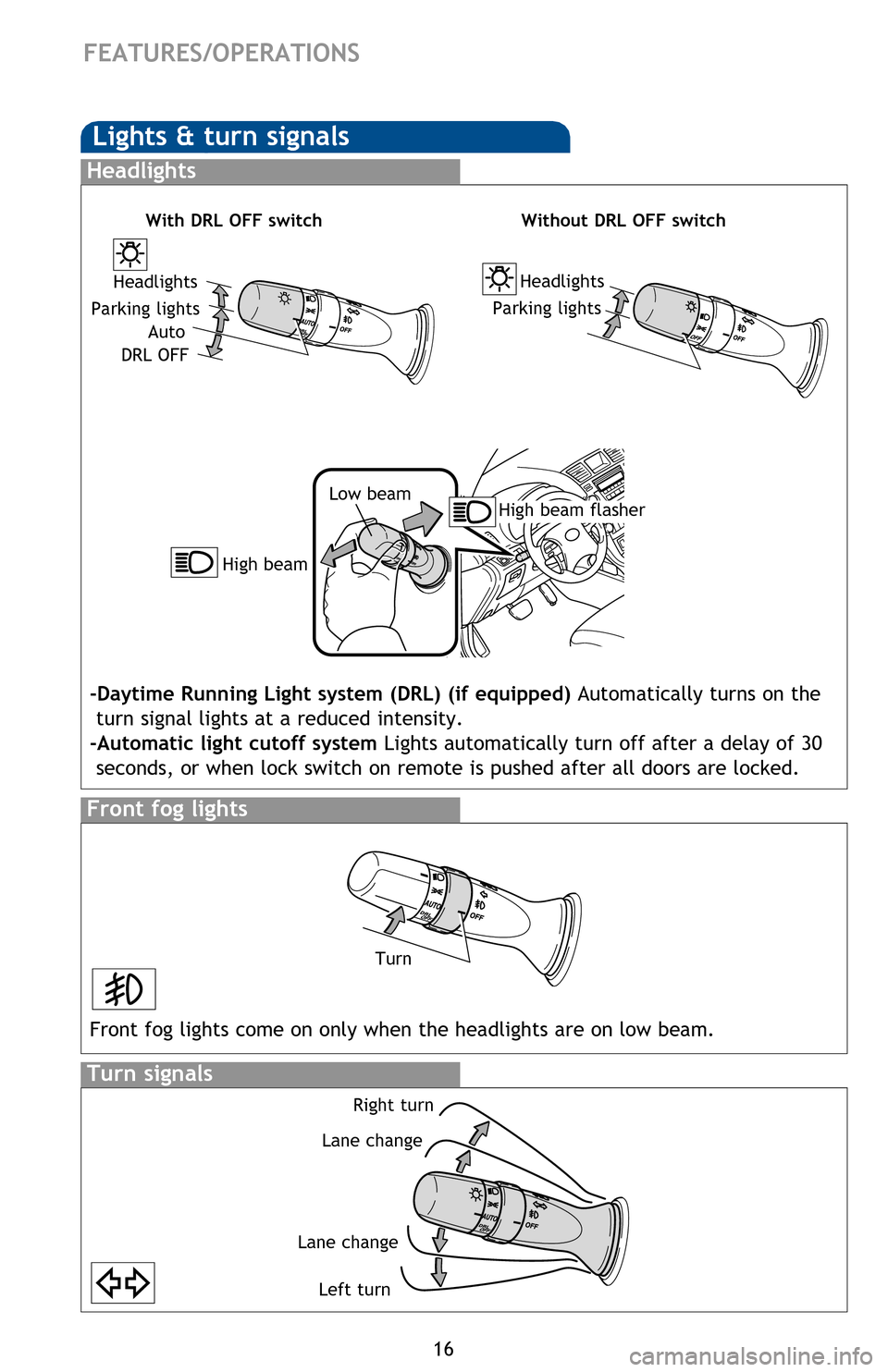
16
Lights & turn signals
Turn signals
Headlights
High beam flasher
Low beam
Front fog lights
-Daytime Running Light system (DRL) (if equipped)
Automatically turns on the
turn signal lights at a reduced intensity.
-Automatic light cutoff system Lights automatically turn off after a delay of 30 seconds, or when lock switch on remote is pushed after all doors are locked.
Front fog lights come on only when the headlights are on low beam.
Right turn
Lane change
Lane change Left turn
High beam
FEATURES/OPERATIONS
Windows-Power
Driver side
Automatic operation (driver’s window only)
Push the switch completely down
or pull it completely up and release to fully open or close. To stop the window
partway, operate the switch in the opposite direction.
Window lock switch Deactivates all passenger windows. Driver’s window remains
operable.
Windshield wipers & washers
Front
Rear
* Intermittent windshield wiper frequency adjustment Rotate to increase/decrease wipe frequency.
Headlights
Parking lightsHeadlights
Parking lights
Auto
DRL OFF
With DRL OFF switchWithout DRL OFF switch
Turn
2013Highlander-HV.indd 168/8/12 9:07 PM
Page 19 of 36
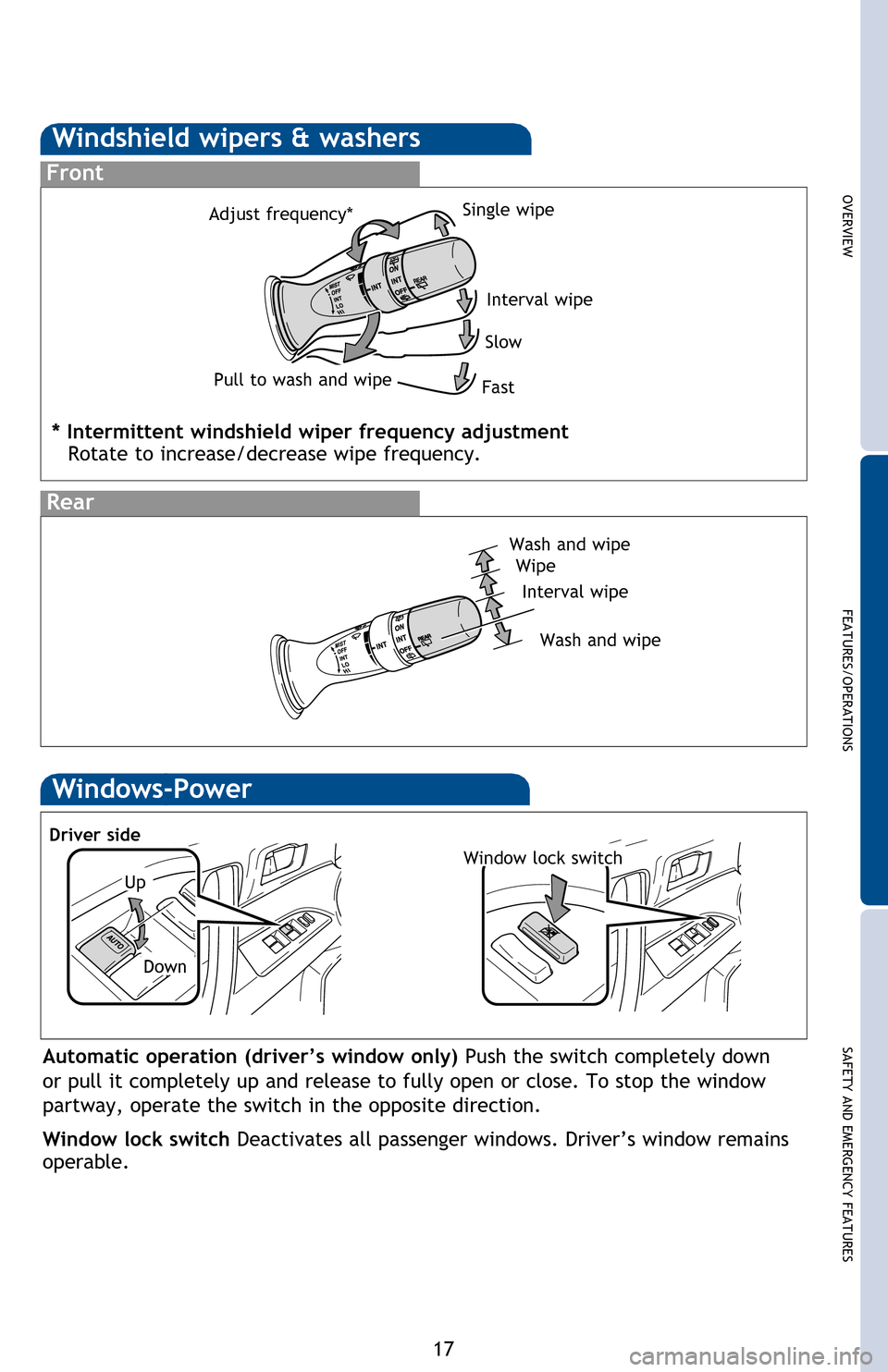
OVERVIEW
FEATURES/OPERATIONS
SAFETY AND EMERGENCY FEATURES
17
-Daytime Running Light system (DRL) (if equipped) Automatically turns on the
turn signal lights at a reduced intensity.
-Automatic light cutoff system Lights automatically turn off after a delay of 30 seconds, or when lock switch on remote is pushed after all doors are locked.
Windows-Power
Up
Down
Driver side
Window lock switch
Automatic operation (driver’s window only) Push the switch completely down
or pull it completely up and release to fully open or close. To stop the window
partway, operate the switch in the opposite direction.
Window lock switch Deactivates all passenger windows. Driver’s window remains
operable.
Windshield wipers & washers
Front
Rear
* Intermittent windshield wiper frequency adjustment Rotate to increase/decrease wipe frequency.
Interval wipe
Single wipe
Slow
Fast
Pull to wash and wipe
Adjust frequency*
Wash and wipe
Wipe
Interval wipe
Wash and wipe
2013Highlander-HV.indd 178/8/12 9:07 PM
Page 20 of 36
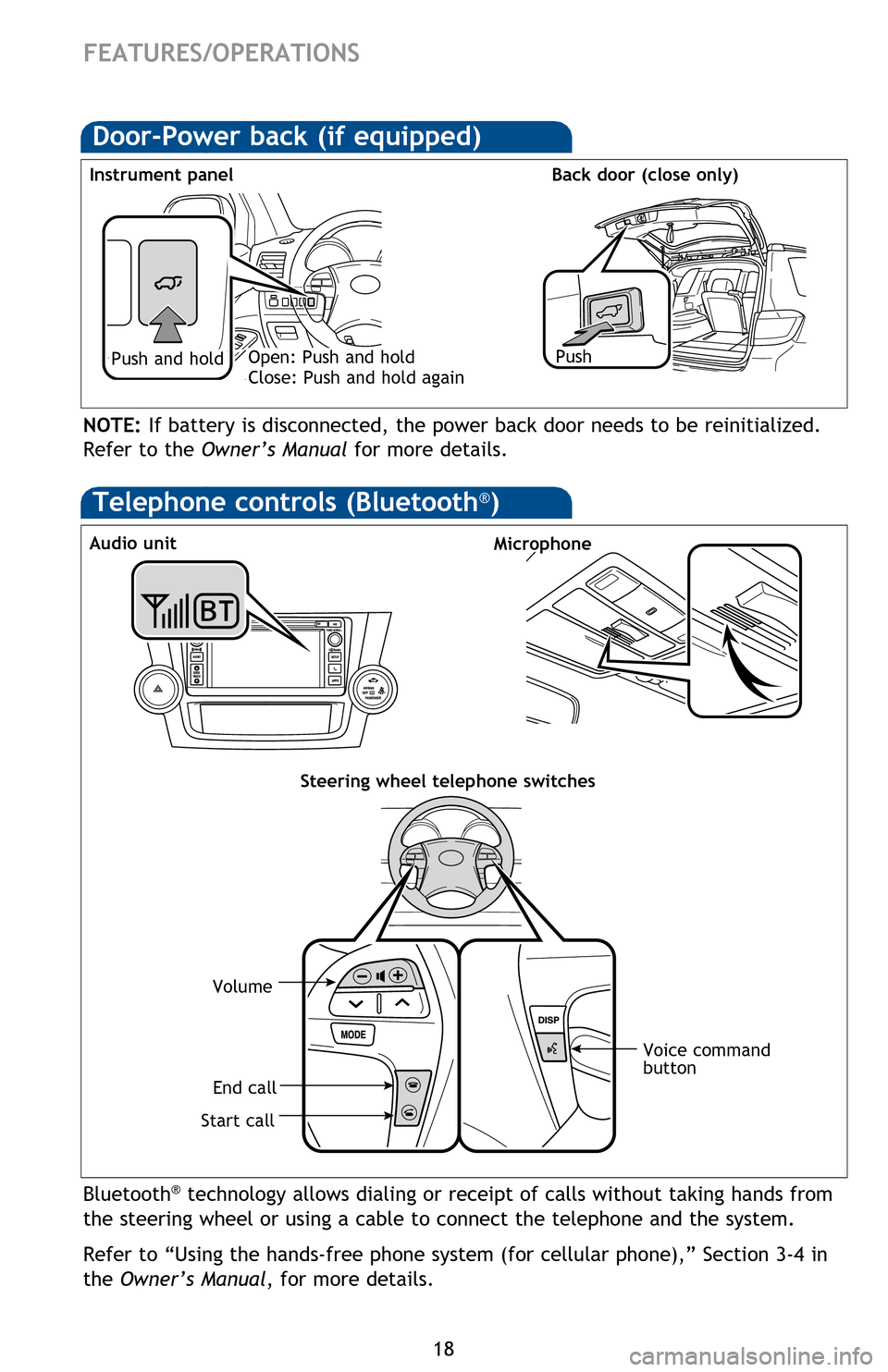
18
FEATURES/OPERATIONS
Door-Power back (if equipped)
PushPush and hold
Instrument panel
Back door (close only)Open: Push and hold
Close: Push and hold again
NOTE: If battery is disconnected, the power back door needs to be reinitialized.
Refer to the Owner’s Manual for more details.
Bluetooth® technology allows dialing or receipt of calls without taking hands from
the steering wheel or using a cable to connect the telephone and the system.
Refer to “Using the hands-free phone system (for cellular phone),” Section 3-4 in
the Owner’s Manual , for more details.
MicrophoneAudio unit
Steering wheel telephone switches
Volume
Start call
End call Voice command
button
Telephone controls (Bluetooth®)
Power outlets-12V DC
Instrument panel (with seat heater)
The “POWER”/ignition switch must be set at “ACC” or “ON” position to be used.
Power outlet-120V AC (if equipped)
Beside second row seat
Center console
The “POWER”/ignition switch must be set at “ON” position to be used.
Clock
Press and hold “DISP” button located on steering wheel. Select “CLOCK” on menu
screen. Adjust as indicated on screen.
2013Highlander-HV.indd 188/8/12 9:07 PM
Page 21 of 36
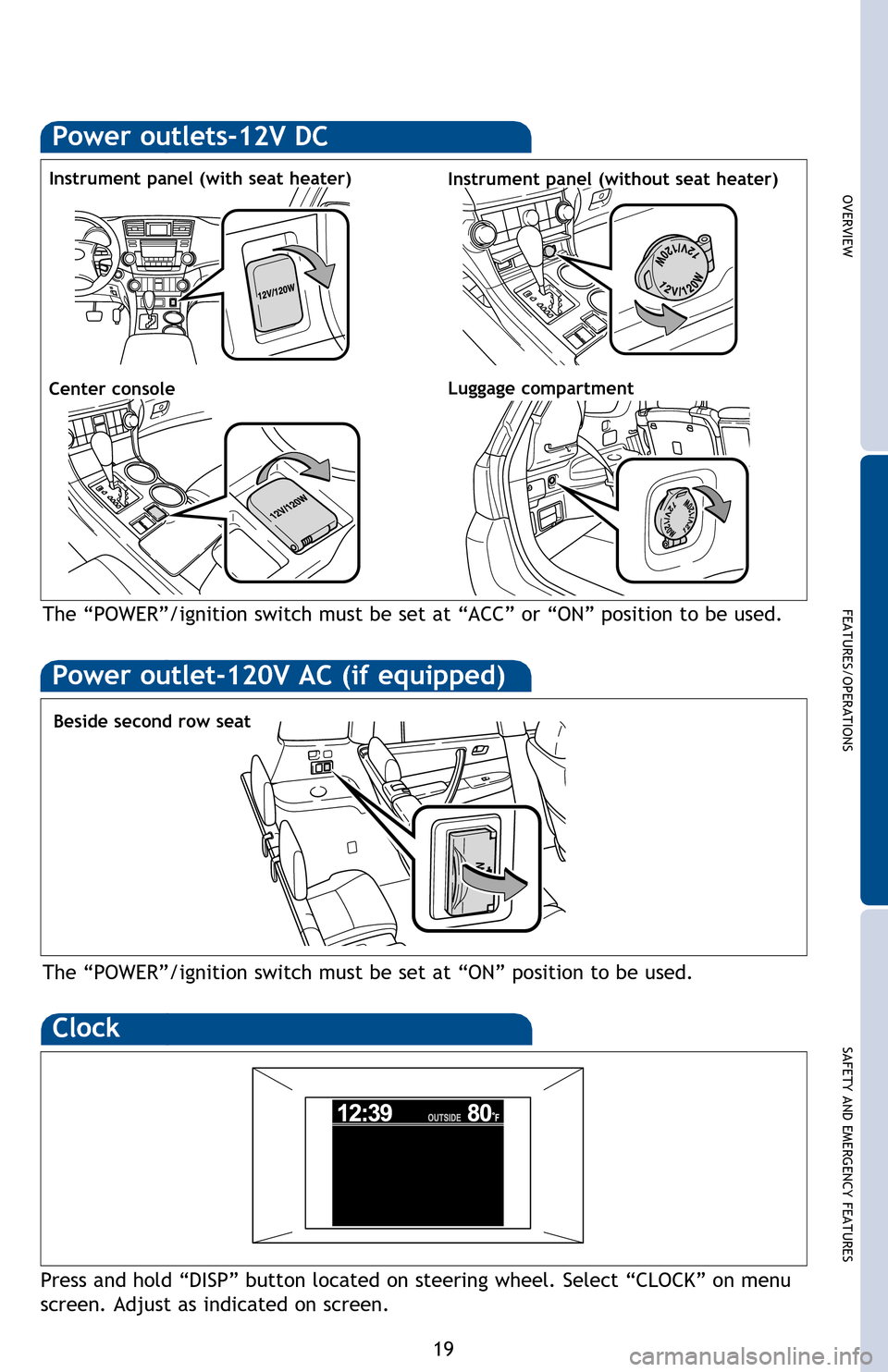
OVERVIEW
FEATURES/OPERATIONS
SAFETY AND EMERGENCY FEATURES
19
NOTE: If battery is disconnected, the power back door needs to be reinitialized.
Refer to the Owner’s Manual for more details.
Bluetooth® technology allows dialing or receipt of calls without taking hands from
the steering wheel or using a cable to connect the telephone and the system.
Refer to “Using the hands-free phone system (for cellular phone),” Section 3-4 in
the Owner’s Manual , for more details.
Power outlets-12V DC
Luggage compartment
Instrument panel (with seat heater)Instrument panel (without seat heater)
The “POWER”/ignition switch must be set at “ACC” or “ON” position to be used.
Power outlet-120V AC (if equipped)
Beside second row seat
Center console
The “POWER”/ignition switch must be set at “ON” position to be used.
Clock
Press and hold “DISP” button located on steering wheel. Select “CLOCK” on menu
screen. Adjust as indicated on screen.
2013Highlander-HV.indd 198/8/12 9:07 PM
Page 22 of 36
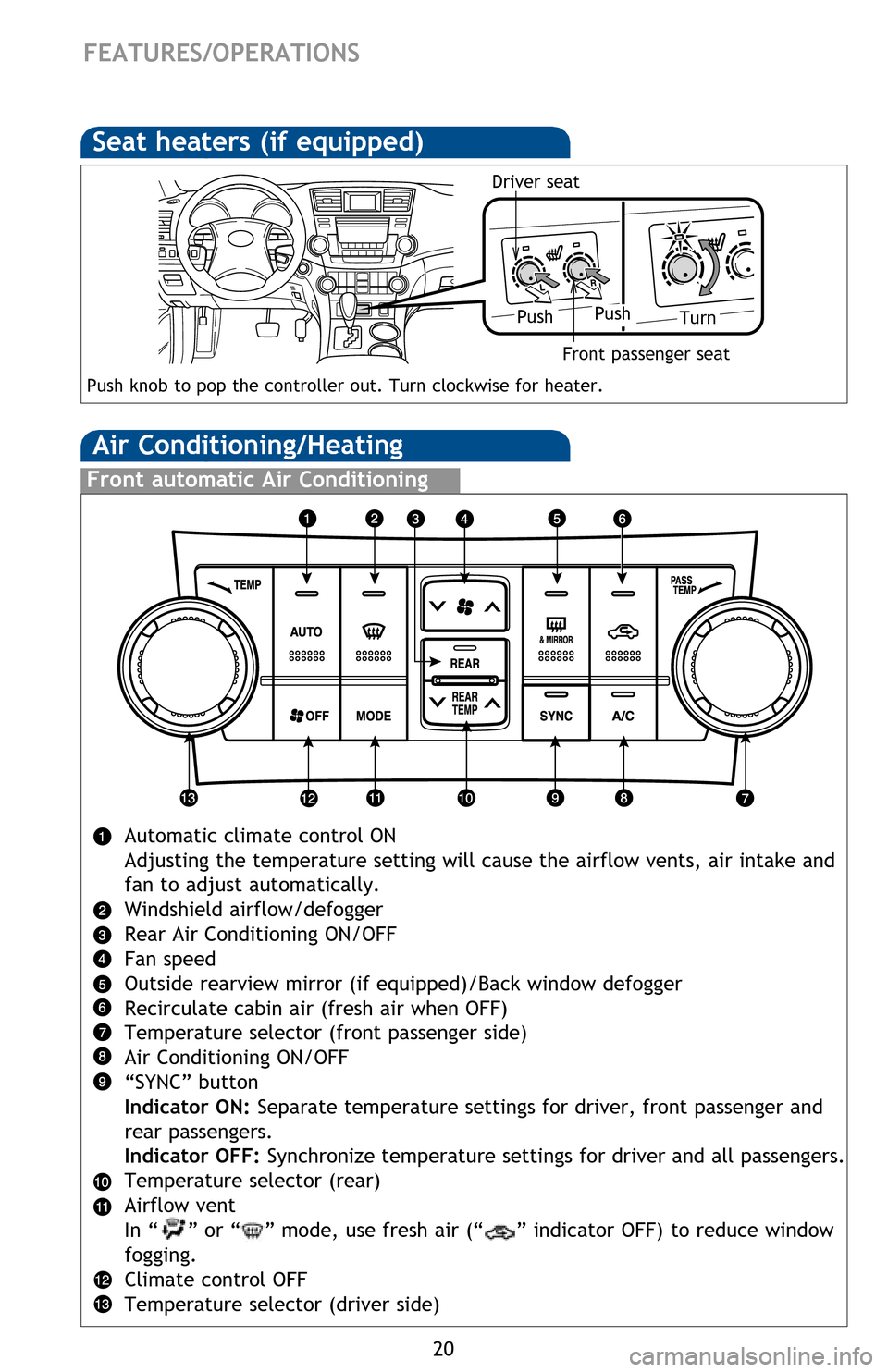
20
FEATURES/OPERATIONS
Air Conditioning/Heating
Front manual Air Conditioning
Fan speed
Outside rearview mirror (if equipped)/Back window defogger
Temperature selector
Recirculate cabin air (fresh air when OFF)
Airflow vent
In “
” or “” mode, use fresh air (“” indicator OFF) to reduce window
fogging.
Air Conditioning ON/OFF
Use fresh air to quickly cool interior, then change to recirculate for cooler air.
Use for quick cooling. Air intake will automatically be set to recirculate.
Rear Air Conditioning ON/OFF
Front automatic Air Conditioning
Automatic climate control ON
Adjusting the temperature setting will cause the airflow vents, air intake and
fan to adjust automatically.
Windshield airflow/defogger
Rear Air Conditioning ON/OFF
Fan speed
Outside rearview mirror (if equipped)/Back window defogger
Recirculate cabin air (fresh air when OFF)
Temperature selector (front passenger side)
Air Conditioning ON/OFF
“SYNC” button
Indicator ON: Separate temperature settings for driver, front passenger and
rear passengers.
Indicator OFF: Synchronize temperature settings for driver and all passengers.
Temperature selector (rear)
Airflow vent
In “
” or “” mode, use fresh air (“” indicator OFF) to reduce window
fogging.
Climate control OFF
Temperature selector (driver side)
Rear automatic Air Conditioning
Fan speed
Temperature selector
Airflow vent
Automatic climate control ON
Climate control OFF
Seat heaters (if equipped)
PushTurn
Push knob to pop the controller out. Turn clockwise for heater.
Push
Driver seat
Front passenger seat
2013Highlander-HV.indd 208/8/12 9:09 PM
Page 30 of 36
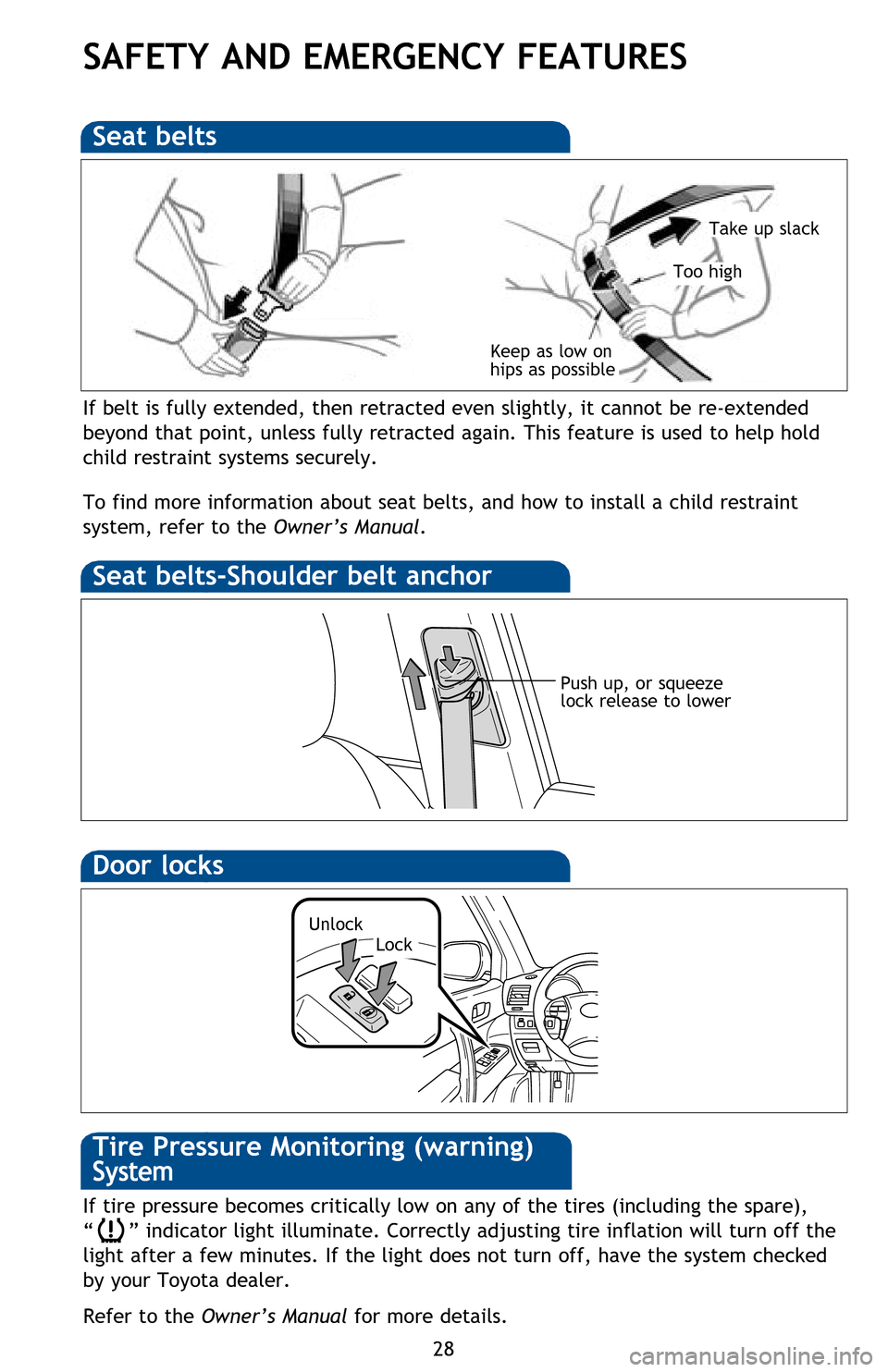
28
SAFETY AND EMERGENCY FEATURES
If belt is fully extended, then retracted even slightly, it cannot be re-extended
beyond that point, unless fully retracted again. This feature is used to help hold
child restraint systems securely.
To find more information about seat belts, and how to install a child restraint
system, refer to the Owner’s Manual.
Keep as low on
hips as possible
Take up slack
Too high
Seat belts
Push up, or squeeze
lock release to lower
Seat belts-Shoulder belt anchor
Door locks
LockUnlock
If tire pressure becomes critically low on any of the tires (including the spare),
“
” indicator light illuminate. Correctly adjusting tire inflation will turn off the
light after a few minutes. If the light does not turn off, have the system checked
by your Toyota dealer.
Refer to the Owner’s Manual for more details.
Tire Pressure Monitoring (warning)
System
Spare tire & tools
Tool location
Removing the spare tire
(1) Remove the cover under the center deck board to find the spare tire clamp bolt.
(2) Assemble the jack handle.
(3) Put the socket adapter on the spare tire clamp bolt. Loosen the bolt by turning
it counterclockwise with the jack handle.
Refer to the Owner’s Manual for tire changing and jack positioning procedures.
Moving the lever downward will allow the door to be opened only from the outside.
Doors-Child safety locks
(1)
Rear door
2013Highlander-HV.indd 288/8/12 9:10 PM
Page 31 of 36
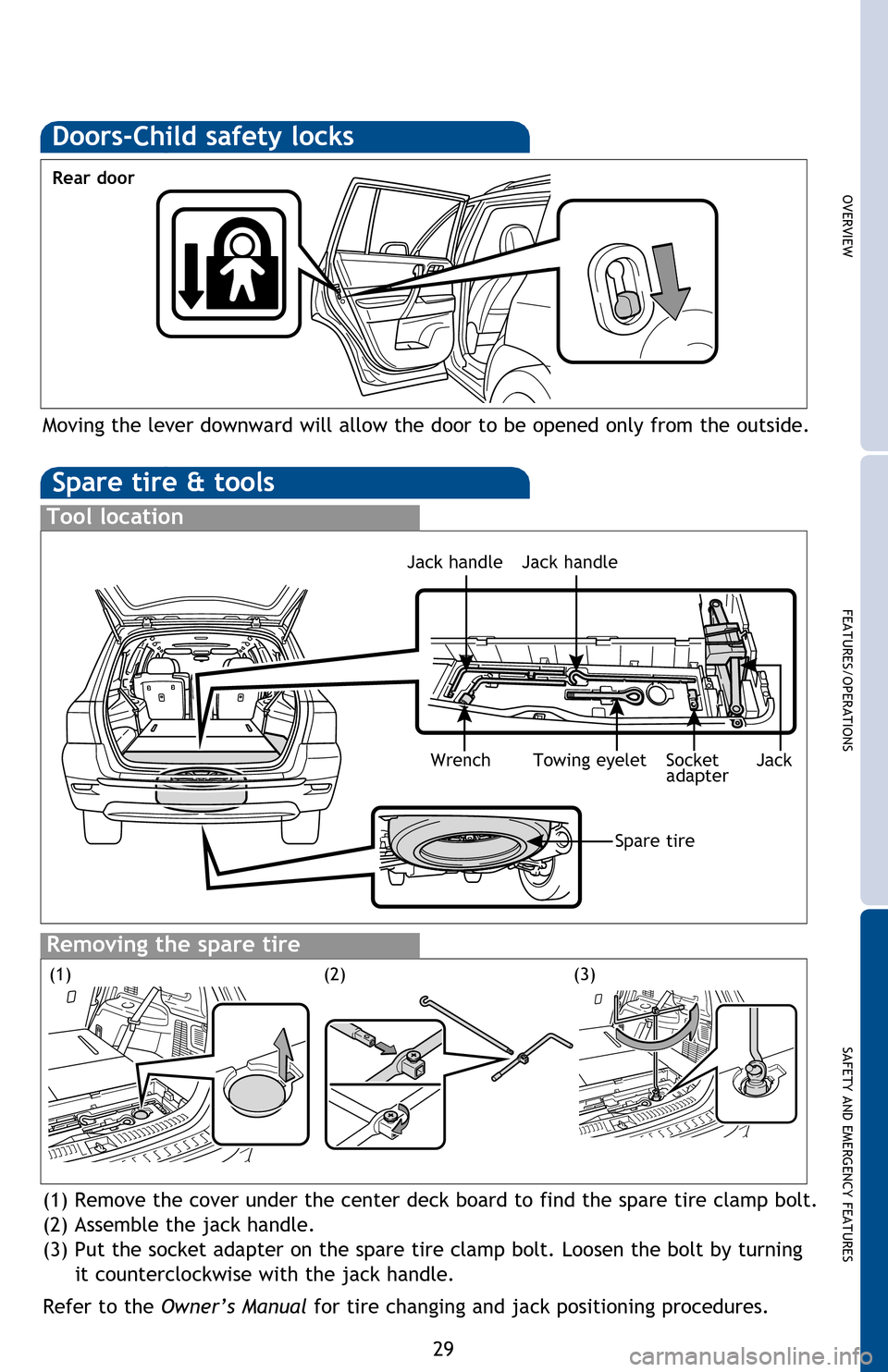
OVERVIEW
FEATURES/OPERATIONS
SAFETY AND EMERGENCY FEATURES
29
If belt is fully extended, then retracted even slightly, it cannot be re-extended
beyond that point, unless fully retracted again. This feature is used to help hold
child restraint systems securely.
To find more information about seat belts, and how to install a child restraint
system, refer to the Owner’s Manual.
Take up slack
If tire pressure becomes critically low on any of the tires (including the spare),
“
” indicator light illuminate. Correctly adjusting tire inflation will turn off the
light after a few minutes. If the light does not turn off, have the system checked
by your Toyota dealer.
Refer to the Owner’s Manual for more details.
Spare tire & tools
Tool location
Removing the spare tire
(1) Remove the cover under the center deck board to find the spare tire clamp bolt.
(2) Assemble the jack handle.
(3) Put the socket adapter on the spare tire clamp bolt. Loosen the bolt by turning
it counterclockwise with the jack handle.
Refer to the Owner’s Manual for tire changing and jack positioning procedures.
Wrench
Spare tire
Jack handle
Towing eyeletSocket
adapter
Moving the lever downward will allow the door to be opened only from the outside.
Jack
Jack handle
Doors-Child safety locks
(2)(3)(1)
Rear door
2013Highlander-HV.indd 298/8/12 9:10 PM
Page 32 of 36
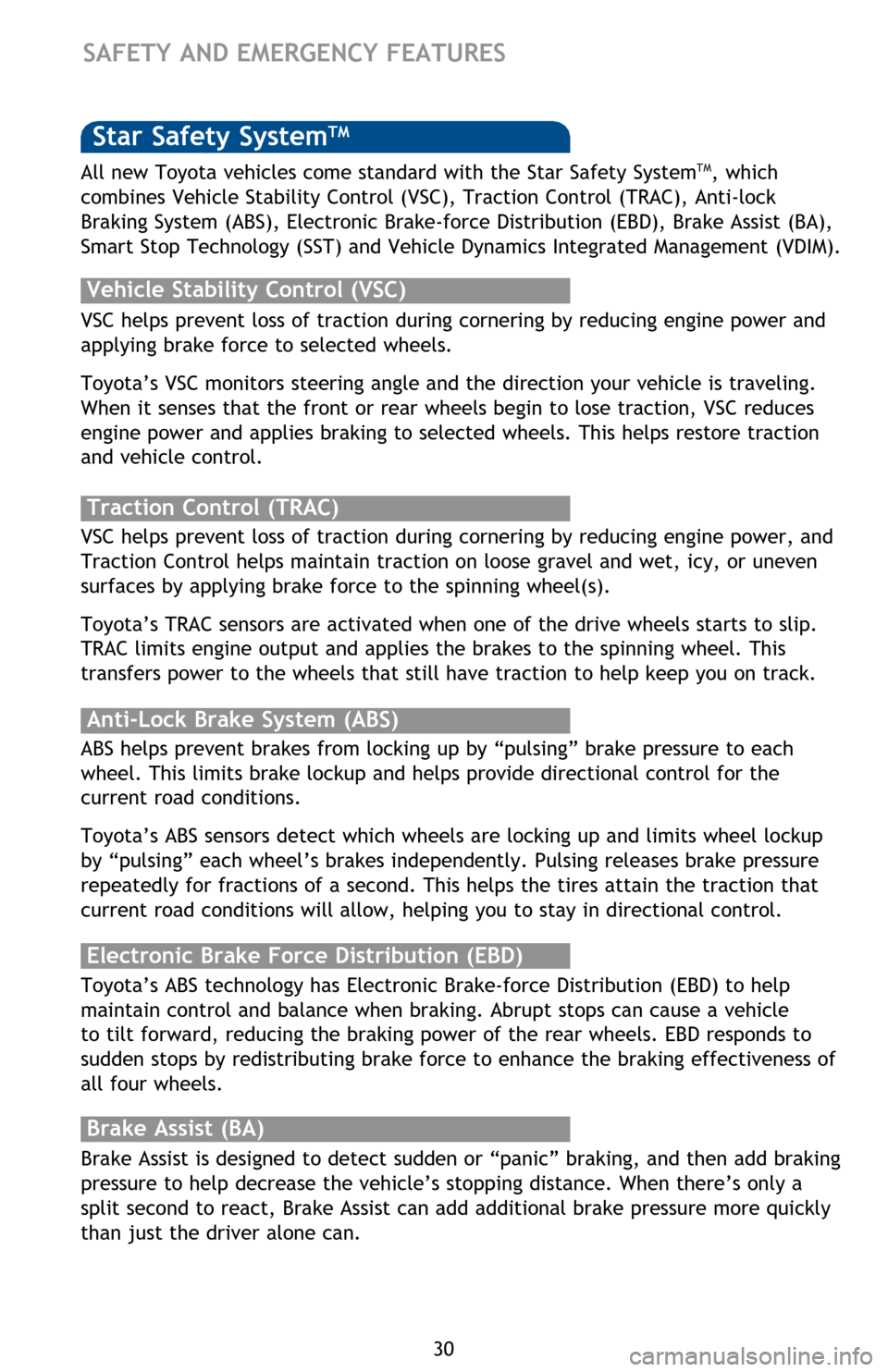
30
There are two types of Toyota floor mats: carpeted and all-weather. Each vehicle
has model-specific floor mats. Installation is easy.
To keep your floor mat properly positioned, follow these steps:
• Only use floor mats designed for your specific model.
• Use only one floor mat at a time, using the retaining hooks to keep the mat in
place.
• Install floor mats right side up.
Floor mat installation
SAFETY AND EMERGENCY FEATURES
Smart Stop Technology automatically reduces engine power when the accelerator
and brake pedals are pressed simultaneously under certain conditions.
SST engages when the accelerator is depressed first and the brakes are applied
firmly for longer than one-half second at speeds greater than five miles per hour.
SST doesn’t engage if the brake pedal is depressed before the accelerator pedal,
allowing vehicles to start on a steep hill and safely accelerate without rolling
backward.
Smart Stop Technology (SST)
Vehicle Dynamics Integrated Management (VDIM)
The Highlander Hybrid employs the advanced Vehicle Dynamics Integrated
Management (VDIM) system.
VDIM is designed to enhance handling, traction and braking systems that normally
react to vehicle driving conditions by anticipating tire slippage before a skid, slide
or wheel spin occurs and helps to make corrections in a smooth, progressive way.
In addition to integrating all of the Highlander’s dynamic control systems (VSC,
TRAC, BA, EPS, EBD and ABS), the VDIM system also employs powerful proprietary
software to integrate the Electronic Throttle Control with intelligence (ETC-i) and
Electronically Controlled Brakes (ECB).
Star Safety SystemTM
VSC helps prevent loss of traction during cornering by reducing engine power and
applying brake force to selected wheels.
Toyota’s VSC monitors steering angle and the direction your vehicle is traveling.
When it senses that the front or rear wheels begin to lose traction, VSC reduces
engine power and applies braking to selected wheels. This helps restore traction
and vehicle control.
Vehicle Stability Control (VSC)
Anti-Lock Brake System (ABS)
ABS helps prevent brakes from locking up by “pulsing” brake pressure to each
wheel. This limits brake lockup and helps provide directional control for the
current road conditions.
Toyota’s ABS sensors detect which wheels are locking up and limits wheel lockup
by “pulsing” each wheel’s brakes independently. Pulsing releases brake pressure
repeatedly for fractions of a second. This helps the tires attain the traction that
current road conditions will allow, helping you to stay in directional control.
Brake Assist (BA)
Brake Assist is designed to detect sudden or “panic” braking, and then add braking
pressure to help decrease the vehicle’s stopping distance. When there’s only a
split second to react, Brake Assist can add additional brake pressure more quickly
than just the driver alone can. VSC helps prevent loss of traction during cornering by reducing engine power, and
Traction Control helps maintain traction on loose gravel and wet, icy, or uneven
surfaces by applying brake force to the spinning wheel(s).
Toyota’s TRAC sensors are activated when one of the drive wheels starts to slip.
TRAC limits engine output and applies the brakes to the spinning wheel. This
transfers power to the wheels that still have traction to help keep you on track.
Traction Control (TRAC)
Electronic Brake Force Distribution (EBD)
Toyota’s ABS technology has Electronic Brake-force Distribution (EBD) to help
maintain control and balance when braking. Abrupt stops can cause a vehicle
to tilt forward, reducing the braking power of the rear wheels. EBD responds to
sudden stops by redistributing brake force to enhance the braking effectiveness of
all four wheels. All new Toyota vehicles come standard with the Star Safety System
TM, which
combines Vehicle Stability Control (VSC), Traction Control (TRAC), Anti-lock
Braking System (ABS), Electronic Brake-force Distribution (EBD), Brake Assist (BA),
Smart Stop Technology (SST) and Vehicle Dynamics Integrated Management (VDIM).
2013Highlander-HV.indd 308/8/12 9:10 PM
Page 33 of 36
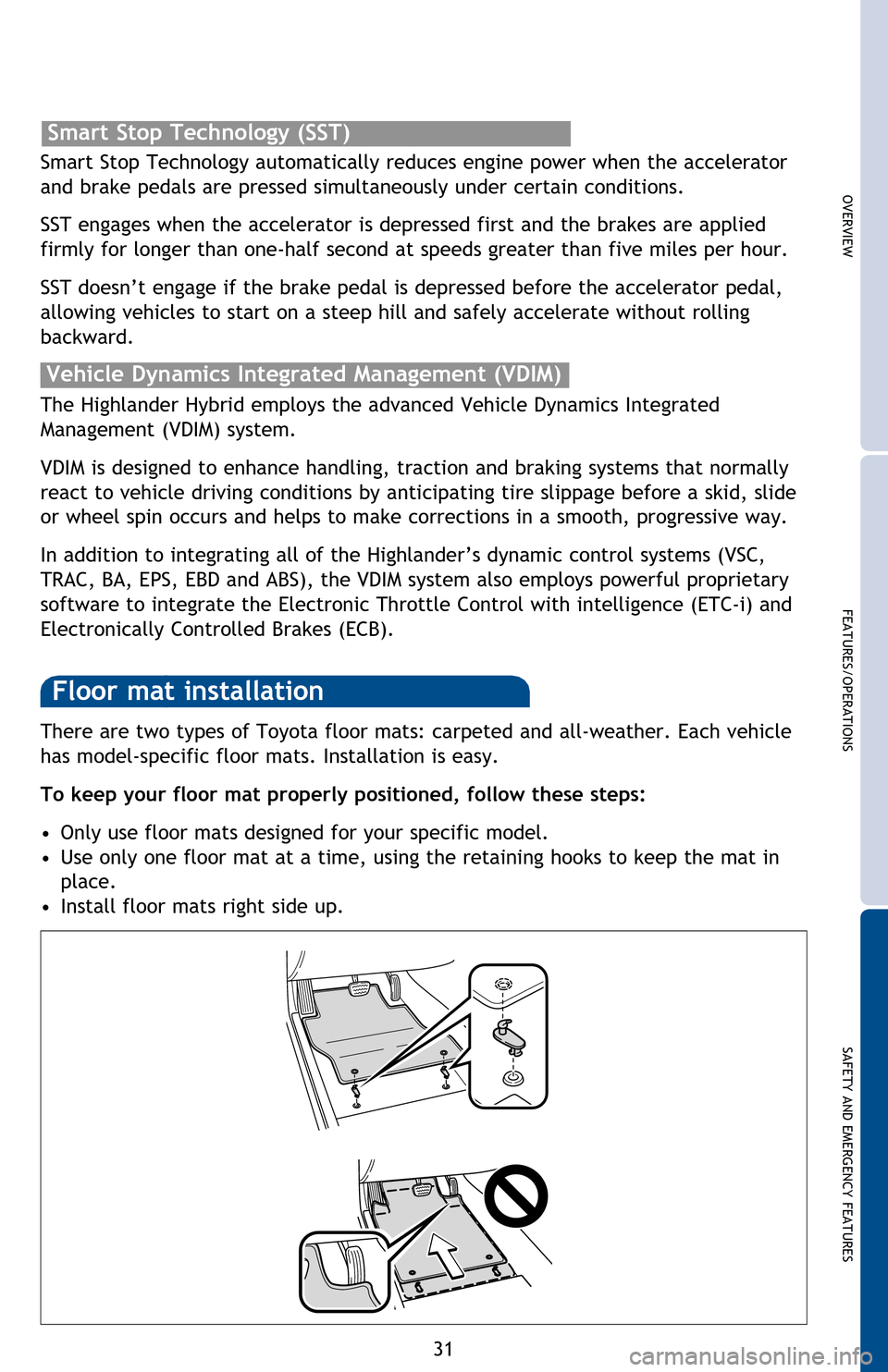
OVERVIEW
FEATURES/OPERATIONS
SAFETY AND EMERGENCY FEATURES
31
There are two types of Toyota floor mats: carpeted and all-weather. Each vehicle
has model-specific floor mats. Installation is easy.
To keep your floor mat properly positioned, follow these steps:
•
Only use floor mats designed for your specific model.
• Use only one floor mat at a time, using the retaining hooks to keep the mat in
place.
• Install floor mats right side up.
Floor mat installation
l
SAFETY AND EMERGENCY FEATURES
Smart Stop Technology automatically reduces engine power when the accelerator
and brake pedals are pressed simultaneously under certain conditions.
SST engages when the accelerator is depressed first and the brakes are applied
firmly for longer than one-half second at speeds greater than five miles per hour.
SST doesn’t engage if the brake pedal is depressed before the accelerator pedal,
allowing vehicles to start on a steep hill and safely accelerate without rolling
backward.
Smart Stop Technology (SST)
Vehicle Dynamics Integrated Management (VDIM)
The Highlander Hybrid employs the advanced Vehicle Dynamics Integrated
Management (VDIM) system.
VDIM is designed to enhance handling, traction and braking systems that normally
react to vehicle driving conditions by anticipating tire slippage before a skid, slide
or wheel spin occurs and helps to make corrections in a smooth, progressive way.
In addition to integrating all of the Highlander’s dynamic control systems (VSC,
TRAC, BA, EPS, EBD and ABS), the VDIM system also employs powerful proprietary
software to integrate the Electronic Throttle Control with intelligence (ETC-i) and
Electronically Controlled Brakes (ECB).
VSC helps prevent loss of traction during cornering by reducing engine power and
applying brake force to selected wheels.
Toyota’s VSC monitors steering angle and the direction your vehicle is traveling.
When it senses that the front or rear wheels begin to lose traction, VSC reduces
engine power and applies braking to selected wheels. This helps restore traction
and vehicle control.
ABS helps prevent brakes from locking up by “pulsing” brake pressure to each
wheel. This limits brake lockup and helps provide directional control for the
current road conditions.
Toyota’s ABS sensors detect which wheels are locking up and limits wheel lockup
by “pulsing” each wheel’s brakes independently. Pulsing releases brake pressure
repeatedly for fractions of a second. This helps the tires attain the traction that
current road conditions will allow, helping you to stay in directional control.
Brake Assist is designed to detect sudden or “panic” braking, and then add braking
pressure to help decrease the vehicle’s stopping distance. When there’s only a
split second to react, Brake Assist can add additional brake pressure more quickly
than just the driver alone can. VSC helps prevent loss of traction during cornering by reducing engine power, and
Traction Control helps maintain traction on loose gravel and wet, icy, or uneven
surfaces by applying brake force to the spinning wheel(s).
Toyota’s TRAC sensors are activated when one of the drive wheels starts to slip.
TRAC limits engine output and applies the brakes to the spinning wheel. This
transfers power to the wheels that still have traction to help keep you on track.
Toyota’s ABS technology has Electronic Brake-force Distribution (EBD) to help
maintain control and balance when braking. Abrupt stops can cause a vehicle
to tilt forward, reducing the braking power of the rear wheels. EBD responds to
sudden stops by redistributing brake force to enhance the braking effectiveness of
all four wheels. All new Toyota vehicles come standard with the Star Safety System
TM, which
combines Vehicle Stability Control (VSC), Traction Control (TRAC), Anti-lock
Braking System (ABS), Electronic Brake-force Distribution (EBD), Brake Assist (BA),
Smart Stop Technology (SST) and Vehicle Dynamics Integrated Management (VDIM).
2013Highlander-HV.indd 318/8/12 9:10 PM